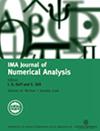A bundle-trust method via gradient sampling technique for nonsmooth optimization using exact and inexact gradients
IF 2.4
2区 数学
Q1 MATHEMATICS, APPLIED
引用次数: 0
Abstract
Based on the proximal bundle and gradient sampling (GS) methods, we develop a robust algorithm for minimizing the locally Lipschitz function $f:\mathbb{R}^{n}\to \mathbb{R}$. As an interesting feature of the proposed method, thanks to the GS technique, we sample a set of differentiable auxiliary points from the vicinity of the current point to construct an initial piecewise linear model for the objective function. If necessary, inspired by bundle methods, we iteratively enrich the set of sampled points by using a single nonredundant auxiliary point suggested by a modified variant of Mifflin’s line search. However, we may terminate the enrichment process without achieving a descent step, which is different from classic bundle methods. Indeed, the proposed enrichment process only accepts those auxiliary points having a small gradient locality measure, which significantly improves the efficiency of the method in practice. In theory, our method keeps iterations where the objective function is differentiable, and consequently, it works only with the gradient vectors of the objective function. In contrast with existing GS methods, the radius of the sampling region is not monotone. More precisely, by proposing a nonmonotone proximity parameter based on the radius of the sampling region, we add some valuable features of the trust region philosophy to our algorithm. The convergence analysis of the proposed method is comprehensively studied using exact and inexact gradients. By means of various academic and semi-academic test problems, we demonstrate the reliability and efficiency of the proposed method in practice.1一种基于梯度抽样技术的基于精确和非精确梯度的非光滑优化束信任方法
基于近端束和梯度抽样(GS)方法,我们开发了一种鲁棒的最小化局部Lipschitz函数$f:\mathbb{R}^{n}\到\mathbb{R}$的算法。该方法的一个有趣的特点是,利用GS技术,我们从当前点附近采样一组可微的辅助点,以构建目标函数的初始分段线性模型。如果有必要,受束方法的启发,我们通过使用一个非冗余的辅助点来迭代地丰富采样点集,该辅助点是由Mifflin线搜索的改进变体所建议的。但是,我们可以在没有实现下降步骤的情况下终止富集过程,这与经典的捆绑方法不同。实际上,所提出的富集过程只接受具有小梯度局部性测度的辅助点,在实践中显著提高了方法的效率。理论上,我们的方法保持了目标函数可微的迭代,因此,它只适用于目标函数的梯度向量。与现有的GS方法相比,采样区域的半径不是单调的。更准确地说,通过提出基于采样区域半径的非单调接近参数,我们将信任域理论的一些有价值的特征添加到我们的算法中。采用精确梯度和不精确梯度对该方法进行了收敛性分析。通过各种学术和半学术测试问题,我们在实践中证明了该方法的可靠性和有效性
本文章由计算机程序翻译,如有差异,请以英文原文为准。
求助全文
约1分钟内获得全文
求助全文
来源期刊
CiteScore
5.30
自引率
4.80%
发文量
79
审稿时长
6-12 weeks
期刊介绍:
The IMA Journal of Numerical Analysis (IMAJNA) publishes original contributions to all fields of numerical analysis; articles will be accepted which treat the theory, development or use of practical algorithms and interactions between these aspects. Occasional survey articles are also published.

 求助内容:
求助内容: 应助结果提醒方式:
应助结果提醒方式:


